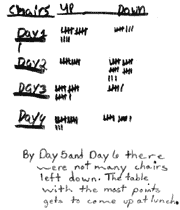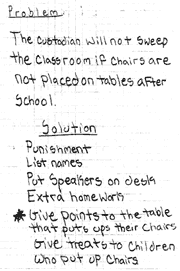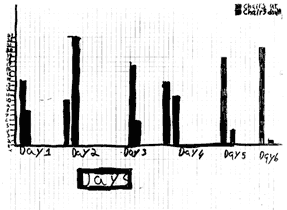Stuff that works: Project Ideas
Chairs Up and Down
Chairs Up and Down
Classroom procedures that are not working well are starting points for Designed Environment projects that deal with procedures. All you need for such a project is to be sensitive to a situation that is not working, and then involve the students in finding the solution. Tonia Bailey, a third grade teacher, did several Designed Environments projects. Here is one of her classroom problems:
Children forget to put their chairs up after school. The custodian will not sweep the classroom if chairs are not placed on tables at the end of the day.
As she worked on Designed Environments projects, Tonia found it difficult to engage the whole class from the beginning, so she developed an approach that worked better for her and her students. She had a small group of students do the initial analysis of the problem that they then shared with the rest of the class. From that point on it became a class project. Tonia tells how this worked with the “Chairs Up and Down” project.

FIGURE 1: A Tally Graph dcumenting the extent of the “Chairs Up and Down” problem
The class was then divided into five groups and each group was told to develop a way to encourage children to put up their chairs. The groups generated many ideas. They put them on chart paper in small groups (see Figure 2), then we met as a group to discuss and share. The children came up in groups and shared their solutions. The children decided to try out one of the solutions for two days: “Give points to the table that puts up their chairs, then let the winning table come up at the end of the week for lunch.” (Figure 3 is a graph showing four days of secret record- keeping and two days after a solution was tried.)

FIGURE 2: One group’s brainstorming list about solutions to the “Chairs Up and Down” problem

FIGURE 3: Bar graph showing the number of chairs up and down before record-keeping became public (Days 1-4) and after a solution was tried (Days 5-6)